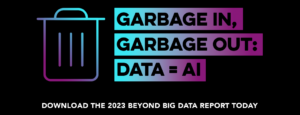Analytics and AI have gone fully mainstream, but there’s a big problem looming amid the Big Data promise: the low quality (and confidence) of the data that’s fueling analytics and AI.

By Dylan Murphy, VP of Product Management at Ocient
These are two of the key takeaways from Ocient’s 2023 Beyond Big Data report. Our survey of 500 IT & data leaders at companies big and small — from $50 million to $5 billion — showed adoption of analytics and AI is becoming universal: 95% are investing in analytics infrastructure, and 92% are looking to use (or already using) AI.
But the survey also pointed to a troubling trend: 1 in 4 tech leaders are concerned about the reliability of their data, and 47% cited data quality as a top data analytics priority — Like the AI and analytics adoption findings, these numbers aren’t outliers. In a recent Accenture CEO survey, 56% of CEOs said data quality was their top challenge. And an HFS Research report from late 2022 found that 3 in 4 (75%) of business executives don’t have a high level of trust in their data — and 1 in 4 (25%) outright do not trust their data with any great certainty.
What are the risks of having bad data quality?
Low-quality data delivers low-quality insights. Put simply, people working with bad data are probably making bad decisions. That’s always the case, but the problem only gets worse when you bring in AI and analytics. Here’s the rub: It’s difficult to fully understand how an algorithm arrived at a specific output or conclusion. And this “black box” challenge of advanced algorithms means it’s harder to recognize when and where things are going off the rails.
Gartner estimated that poor data quality costs organizations an average $12.9 million every year, and experts from the UK Data Management Body of Knowledge think data quality issues cost companies 10-30% of their annual revenue.
So where exactly is money leaking out through low-quality data? Improper resource allocation is the main culprit. Inaccurate operational insights lead to operational issues, bottlenecks, uncaptured demand, etc. The same shortcomings show up in inaccurately optimized service delivery. On a broader business-decision-making level, leaders operating with low-quality data end up creating strategic plans and making investments in the wrong areas, which can ultimately end up steering their companies in the wrong directions.
Thankfully, most companies catch the outcomes of low-quality data insights before they go on for too long. But this means they’re then spending time and money fixing things — not just remediating the bad decisions based on bad data, but resolving the poor data quality itself. All of this has the residual effect of dragging down a company’s speed and agility — two things every company is prioritizing right now.

Low trust is just as bad as low quality — especially with regards to AI
One profound insight we’ve gleaned in our experience helping enterprises with their hyperscale data demands is that self-reported confidence in data quality is typically lower than actual data quality. In other words, business leaders think their data is unreliable — so they don’t trust it for decision-making. But even if you’re able to identify a bad output, it’s not easy to determine whether it was the data, or the algorithm.
Driving data readiness for the new AI frontier
As a wave of new AI tools accelerates across the business world, one of the big break points will be between organizations with high vs. low trust in the fidelity of the AI-derived insights. If you’re not confident in the fidelity of the data fueling your AI, then you’re definitely not going to trust the AI outputs. It’s the inherent uncertainty of the black box problem amplified by outright distrust in the inputs.
This is creating a new urgency around data quality. Today, companies still have the opportunity to correct the outcomes of poor data quality (and avoid or fix suboptimal decision-making). But in the not-so-distant future, businesses that can’t confidently lean into AI-powered insights will be completely left behind by those that can. Organizations with low-trust in data won’t have the visibility to see new opportunities and anticipate where the market is headed. As a result, they also won’t have the agility to get ahead of those shifts — which makes holding a competitive edge against those using trusted, reliable data all but impossible.
Right now, every company should make it a priority to enhance data quality (and the data confidence that comes with it), so they’re ready to lean into the coming wave of AI-powered innovation.

Keep an eye out for our next blog, where we’ll dive more into what business leaders are doing to build and sustain data quality. In the meantime, you can always reach us here.

